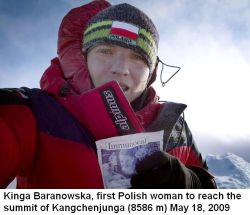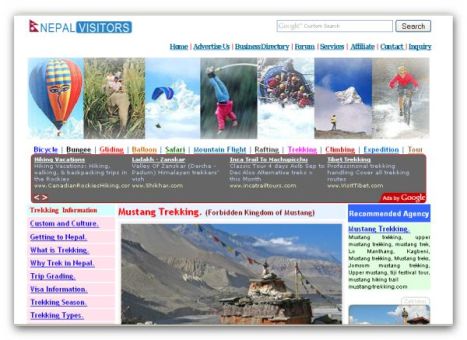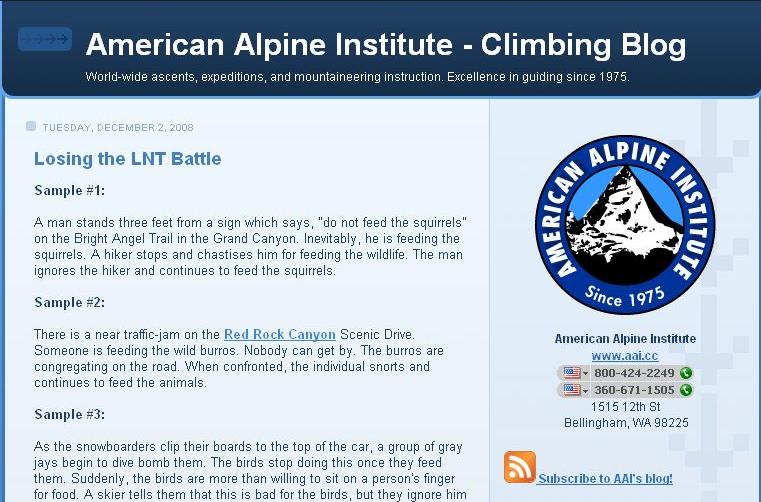I Recommend….
Nepal travel and trekking information. Includes, tour, tourism, trek, hiking, expedition, peak climbing, adventure holidays trips in Nepal.
Mustang has a long, rich and complex history that masks it one of the most interesting place in Nepal. The early history of Lo is Surrounded in legend. Myth and mystery, But there are records of events in Lo as early as the 8th century. It is quite likely that the Tibetan poet Milarepa, who lived from 1040 to 1123, visited Lo. Upper Mustang was once part of Ngari, a name for far western Tibet. Ngari was not a true political entity, but rather a loose collection of feudal domains that also included parts of Dolpo. By the 14th Century, much of Ngari, as well as most of what today is western Nepal, was part of the Malla empire governed from the capital at Sinja, near Jumla. It is generally believed that Ame Pal (Ama-dpal in Tibetan ) founded Lo in 1380 and was its first king. The Ancestry of the present Mustang Raja can be traced 25 generations back to Ame Pal. Ame Pal, or perhaps his father, conquered a large part of the territory in the upper Kali Gandaki and was responsible for the development of the city of Lo Manthang and many gompas. To the west, the Malla empire declined and split into numerous petty hill states. By the 18th century, Jumla had consolidated and reasserted its power. In an effort to develop their domain as a trading centre and to obtain Tibetan goods, the rulers of Jumla turned their attention eastward. In the mid-18th century they assumed control over Lo, from which they extracted as annual tribute. When he ascended the throne in 1762, prithvi Narayan Shah began to consolidated what is present-day nepal. At the time of his death, the kingdom extended from Gorkha eastward to the borders of Sikkim. His descendants directed their efforts westward and by 1789, Jumla had been annexed. The Gorkha armies never actually entered Lo; they recognized the rule of the Mustang Raja. Although Mustang became par of Nepal, the raja retained his title and Lo retained a certain amount of autonomy. Lo maintained its status as a separate principality until 1951. After the Rana rulers were overthrown and king Tribhuvan reestablished the rule of the Shah monarchs on 15 February 1951, Lo was more closely consolidated into Nepal. The raja was given the honorary rank of colonel in the Nepal army.
Mustang Trek
During the 1960s, after the Dalai lama had fled to India and Chiness armies established control over Tibet, Mustang was a centre for guerrilla operations against the Chinese. The soldiers were the Khampas, Tibet’s most fearsome warriors, who were backed by the CIA (some Khampas were secretly trained in the USA). At the height of the fighting there were at least 6000khampas in Mustang and neighboring border areas. The CIA’s support ended in the early 1970s when the USA, under Kissinger and Nixon, Initiated new and Better relations with the Chinese. The government of Nepal was pressed to take action against the guerrillas and, making use of internal divisions within the Khampa leadership, a bit of treachery and the Dalai Lama’s taped advice for his citizens to lay down their arms, it managed to disband the resistance without committing to action the 10,000 Nepali troops that had been sent to the area.
Mustang Trek
Though Mustang was closed, the vovernment allowed a few researchers into the area.Toni hagen included Mustang in his survey of the entire kindom of Nepal, and the Italian scholar Giuseppe Tucci visited in the autumn of 1952. Professor David Snellgrove travelled to the gegion in 1956 but did not visit Lo Manthang. Longtime Nepal resident Barbara Adams travelled to Mustang during the autumn of 1963.The most complete description of the area is Mustang, the Forbidden Kingdom, written by Michel Peissel, who spent several months in the area in the spring of 1964, Dr Harka Bahadur Gurung also visited and wrote about upper Mustang in October 1973. A number of groups legally travelled to upper Mustang during the 1980s by obtaining permission to climb Bhrikuti (6364), south-east of Lo Manthang.Other than a few special royal guests, the first legal trekkers were allowed into Mustang in March 1992 upon payment of a high fee for a special trekking permit.
Only camping trek allowed:
Completely closed to foreign trekkers until 1991, Mustang is an ancient Himalayan Kingdom. Inside the walled city of Lo Manthang are some of the largest Tibetan Buddhist gompas in Nepal. A difficult trek because of high altitude, exposed terrain and continual Strong winds.
Trip Facts:
Trekking Destination : Mustang Trek
Minimum altitude : 2810m.
Maximum altitude : 4,100m. (Ghar Gumba)
Grade :
Season : Spring & Autumn
Accommodation : Tented Camp
Duration : 17 Days
Minimum group size: 2 pax
Cost:$2050
Suggested Itinerary :
Day 01: Arrive Kathmandu & Transfer to Hotel.
Day 02: Full day guided sightseeing around of the Kathmandu valley. Join us for the welcome dinner at evening.
Day 03: Fly to Pokhara. Free to explore its attractions.
Day 04: Fly to Jomsom (2,700m), trek to Kagbeni (2,800m) (4 hrs) Camp
Day 05: Trek Kagbeni to Chhukasang (3,060m) (5-6 hrs). Camp.
Day 06: Trek Chhukasang to Samar (3,570m) (7-8 hrs). Camp.
Day 07: Trek Samar to Dhakmar (3,560m) (6-7 hrs). Camp.
Day 08: Trek Dhakmar to Tsarang (3,840m) (4-5 hrs). Camp.
Day 09: Trek Tsarang to Lo-Manthang (3,840m). Camp.
Day 10: Trek Lo-Manthang (Visit Eastern and Western Valley )
Day 11: Trek Lo-Manthang to Yara. (6 hrs). Camp.
Day 12: Trek Yara to Tangy (2,600m) (8 hrs). Camp.
Day 13: Trek Tangy to Tetang (2,600m). Camp.
Day 14: Trek Tetang to Muktinath (3,600m) (5 hrs). Camp.
Day 15: Trek Muktinath To Jomsom (2700m)(4 hrs). Camp.
Day 16: Flight Jomsom – Pokhara – Kathmandu.
Day 17: Free day to explore, and enjoy Kathmandu.
Day 18: Final Departure.
Copyright Contain By:
Nepal Visitors Network
P.O. Box :19760, Thamel, Kathmandu, Nepal.
Tel :+977-1-4263133, Fax:+977-1-4216454, +9779841258665 (M)
Skype: nepalvisitors
info@nepalvisitors.com
* Source :- http://himalman.wordpress.com/ – http://www.nepalvisitors.com/
** zapraszam na relacje z wypraw polskich himalaistów.













































0 Response to "Nepal Trekking – Mustang Trek (Forbidden Kingdom of Mustang)."